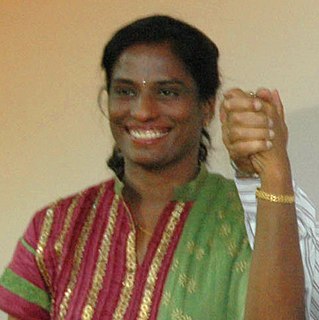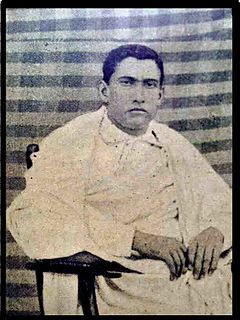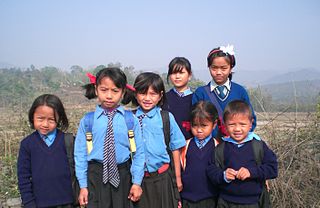Vaishya is one of the four varnas of the Hindu social order in India and Nepal. Vaishyas are classed third in the order of caste hierarchy.

Bana, also referred to as Banasura, is an asura king in Hindu mythology, ruling from the city of Sonitapura. He is described to be the son of Mahabali. His tale of battling Krishna is described in the Bhagavata Purana.

The Varman dynasty (350-650) was the first historical dynasty of the Kamarupa kingdom. It was established by Pushyavarman, a contemporary of Samudragupta. The earlier Varmans were subordinates of the Gupta Empire, but as the power of the Guptas waned, Mahendravarman (470-494) performed two horse sacrifices and the status of Kamarupa as independent state remained umimpaired. According to the Allahabad Prasasti, the ruler of Kamarupa was a frontier ruler (Pratyanta-nrpatis) of the great Gupta emperor.

Pilavullakandi Thekkeraparambil Usha is a retired Indian track and field athlete. She was born in Kuttali, Kozhikode, Kerala. She has been associated with Indian athletics since 1979. She has won 4 asian gold medals and 7 Silver medals. She is often called the "Queen of Indian track and field". On 6 July 2022, she was nominated to the Rajya Sabha by President Ram Nath Kovind.

Aniruddhatransl. 'unconquered' is a character in Hindu mythology, the son of Pradyumna and Rukmavati, and the grandson of Krishna and Rukmini. He is said to have been very much like his grandfather, to the extent that he is considered by some to be a Jana avatar, an avatar of Vishnu. He is a member of the chatur-vyuha, the four Vrishni heroes.

Pitambar Deva Goswami was a spiritual leader and social reformer in the Indian state of Assam. At age six, he was accepted into the monastic order of the Garamur Satra. Goswami was schooled in Sanskrit by Nityanandadeva Bhagawati Vidyavagish in the satra. When he was 21, he was appointed Satradhikar of the Garamur Satra after the death of Jogachandra Deva Satradhikar Goswami.

Assam is the main and oldest state in the North-East Region of India and as the gateway to the rest of the Seven Sister States. The land of red river and blue hills, Assam comprises three main geographical areas: the Brahmaputra Valley which stretching along the length of the Brahmaputra river, the Barak Valley extending like a tail, and the intervening Karbi Plateau and North Cachar Hills. Assam shares its border with Meghalaya, Arunachal Pradesh, Nagaland, Manipur, Tripura, Mizoram and West Bengal; and there are National Highways leading to their capital cities. It also shares international borders with Bhutan and Bangladesh and is very close to Myanmar. In ancient times Assam was known as Pragjyotisha or Pragjyotishpura, and Kamarupa.

Ghugni or ghuguni is a curry made of peas or chickpeas. Different variations of the dish use different types of peas or chickpaes, such as black gram, green peas, or white peas. It is a snack native to the Indian subcontinent, especially popular in Eastern India, Northeast India and in Bangladesh.

Lower Assam is a region situated in Western Brahmaputra Valley encompassing undivided Kamrup and Goalpara regions. Soon after the formal creation of the British districts in 1833, Lower Assam denoted one of the five initial districts that were created west of the Dhansiri river, which, along with the six paraganas, became a single district of Kamrup in 1836. It was home to the kingdom of Kamarupa, ruled by Varman's and Pala's from their capital's Pragjyotishpura (Guwahati) and Durjaya. Today Guwahati is the largest city of North-East India while Dispur, the capital of Assam, is within the town.

Pushyavarman was the first historical ruler of Kamarupa (Assam) in eastern India, who established the Varman dynasty in 350 AD.

Kamrupi dialects are a group of regional dialects of Assamese, spoken in the Kamrup region. It formerly enjoyed prestige status. It is one of two western dialect groups of the Assamese language, the other being Goalpariya. Kamrupi is heterogeneous with three subdialects— Barpetia dialect, Nalbariya dialect and Palasbaria dialect.

Ojapali is a traditional shamanistic type of indigenous folk dance from Assam in the northeastern region of India. Ojapali is believed to have evolved from Kathakata tradition and is performed in a group; it is believed to be one of the oldest art forms of Assam. Originally evolved in the Kamata state the western and northern part of river Brahmaputra later limited to Darrang area under the patronisation of Darrangi King Dharmanarayana. The repertoire of this performance consists of songs, dialogues, gesture, improvised acting and dramatisation etc. The group consists of an Oja, who leads the performance and four or five palies, who supplement the performance with continuously playing cymbal. Among the Palies Daina pali who stand on the right-hand side of the Oja is the active one and he and Oja take the performance forward. Many believe that Shankardev took inspiration from Ojapali to create his Ankiya Bhaona. Moreover he also created his own Sattriya Ojapali. Generally Darrangi Suknanni Ojapali sings the lyrics written by Sukabi Narayanadeva in Padmapurana. Padma Purana covers the story of serpent goddess Maroi(manasa devi). Ojapali is associated with Shakti Puja, including the deities manasa, kali, durga, kesikhaiti, kakogoshani etc.

Davaka was a kingdom of ancient Indian subcontinent, located in current central region of Assam state. The references to it comes from the 4th century Allahabad pillar inscription of Samudragupta, where it is mentioned as one of five frontier kingdoms of the Gupta Empire.
Pitambar Pant was an Indian independence activist, civil service officer and writer, best known for his contributions for the establishment of the Central Statistics Office and for changing Indian system of measurement to metric system. He served as the secretary to Jawaharlal Nehru, the then prime minister of India and headed the perspective planning division of the Planning Commission of India. He was also the author of a number of books on socialist economics. The Government of India awarded him the Padma Bhushan, the third highest civilian award, in 1973.
The Khoirabari massacre was an ethnic massacre of an estimated 100 to 500 immigrant Bengalis in the Khoirabari area of Assam, India, on 7 February 1983. Activists of the Assam Agitation sought to block an assembly election that day and had cut communications to the Bengali enclaves, which were perceived to be pro-election. Indigenous Assamese groups, who had held resentments toward the immigrant Bengalis, took advantage of the resulting isolation and surrounded and attacked the Bengali villages at night.

The hill tribes of Northeast India are hill people, mostly classified as Scheduled Tribes (STs), who live in the Northeast India region. This region has the largest proportion of scheduled tribes in the country.
Mahendra Manikya was the Maharaja of Tripura from 1712 to 1714.

Bhaskar Jyoti Mahanta is a 1988 batch (41RR) IPS officer of Assam-Meghalaya cadre. He is the current Director General of Assam Police, and had previously served as the special Director General of Border.













